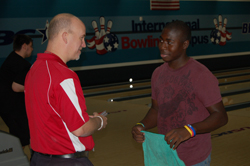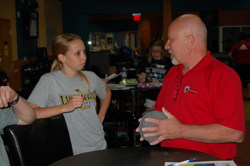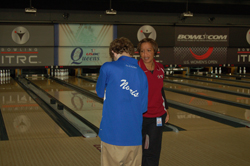ITRC hosts Youth Gold Camp
June 08, 2012

 The International Training and Research Center in Arlington, Texas, hosted nearly 30 USBC Youth bowlers on Friday to take part in the Youth Gold Camp, a training camp to help them prepare for next month’s North Pointe Junior Gold Championships.
The International Training and Research Center in Arlington, Texas, hosted nearly 30 USBC Youth bowlers on Friday to take part in the Youth Gold Camp, a training camp to help them prepare for next month’s North Pointe Junior Gold Championships.“The goal is to give these youth bowlers the knowledge and experience they will need to do well on the patterns they’ll compete on at Junior Gold,” Team USA head coach Rod Ross said. “We run classroom sessions where we give an overview of each pattern and talk about ball motion and lane play, and we give the bowlers the opportunity to practice on each of the patterns, all for a very reasonable fee.”
The ITRC offers youth camps throughout the year that focus on a variety of themes, such as lane play, ball motion, the physical game, and many other aspects of the sport. Friday’s camp was the first to focus specifically on how to play the patterns bowlers will face at the North Pointe Junior Gold Championships, which takes place July 14-20 in Indianapolis.
Each of the three five-game qualifying blocks at this year’s Junior Gold tournament will feature a different World Tenpin Bowling Association lane pattern—one short, one medium, and one long pattern. Adding to the unique challenge of this tournament, bowlers will have to face each pattern in a different bowling center, as the more than 2,100 bowlers registered to bowl this year’s event will bowl across three centers in the Indianapolis area—Western Bowl, Expo Bowl, and Woodland Bowl.
 “These patterns can become very difficult if you don’t have a lot of background knowledge about lane play,” Ross said. “I have seen very talented individuals play these patterns with the wrong ball in the wrong part of the lane and just make the patterns even harder, and then they get frustrated.
“These patterns can become very difficult if you don’t have a lot of background knowledge about lane play,” Ross said. “I have seen very talented individuals play these patterns with the wrong ball in the wrong part of the lane and just make the patterns even harder, and then they get frustrated.“Everyone in this camp will go home with a workbook that explains ball motion and lane play, and another that explains the three different patterns they will see at Junior Gold. This is a great opportunity for these players, because they don’t usually get the chance to practice on WTBA patterns.”
Camp attendees enjoyed access to some of the cutting-edge technology that makes the ITRC an ideal environment in which to train for major youth events such as the North Pointe Junior Gold Championships, including a DVR system that allows players to watch each of their shots on a large screen as soon as they step off the lane, a multimedia classroom that enables intensive study of lane patterns and ball motion, a consistent lane surface from pair to pair, and state-of-the-art lane machines that are checked for compliance on a weekly basis to ensure the integrity of the lane patterns.
“Another advantage of training here is that the ball returns are not on the approach,” Ross said. “Most centers have the ball return on the approach, which forces you to play certain lines. Here, we take that obstacle out of the equation, which allows bowlers complete freedom to experiment with different lines and angles.”
A United States Olympic Committee-recognized training center, the ITRC is a joint venture of USBC and the Bowling Proprietors' Association of America. It is the most innovative and advanced training, research and testing facility in the sport of bowling with 14 lanes for training and six for research and testing.
 But beyond all the technology and the emphasis on ball motion and lane play, the thing Ross recommends the most for players who wish to succeed at the North Pointe Junior Gold Championships is patience.
But beyond all the technology and the emphasis on ball motion and lane play, the thing Ross recommends the most for players who wish to succeed at the North Pointe Junior Gold Championships is patience.“I see too many players get panicked and they get themselves in trouble; they try to shoot 300 with one ball,” Ross explained. “It is a long format, so don’t let one bad shot get in your way. Don’t let one bad game get in your way. You don’t have to be perfect the whole tournament. Just be patient, keep grinding, and stay focused.”
Most of all, the Youth Gold Camp is another opportunity to fulfill USBC’s ongoing effort to create lifelong bowlers, a goal Ross bears in mind with every youth camp that comes through the ITRC.
“These are youth bowlers; they are the future of our sport,” Ross explained. “We want them to bowl for a lifetime, and that’s why we need to educate them.”





